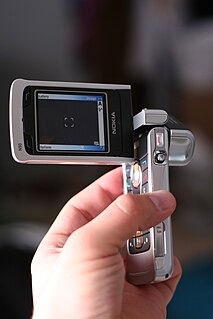This article needs additional citations for verification .(May 2007) (Learn how and when to remove this template message) |

A swivel lens is a lens that freely rotates while attached to a camera body. They are used on some compact digital and video cameras (camcorders). These lenses make it easy for a photographer to aim a camera without moving around too much. Swivel lenses come in different sizes and shapes. A swivel lens is also known as a swiveling lens, swivelling lens, and rotating lens.

A camcorder is an electronic device originally combining a video camera and a videocassette recorder.
Contents
- Uses
- List of cameras that have swivel lens
- List of other devices with swivel lens
- Cellphones
- Cellphones with pseudo swivel lens
- See also
- References
In contrast, swivel LCDs (also known as articulating screen) are displays that freely rotate while attached to a camera body. Usually, the camera body is much larger than the swivelling display. Swivel LCD devices can be considered as swivel lens devices because the camera body can swivel around the small display; albeit, aiming the camera is more difficult. Most camcorders have a swivel LCD.

An articulating screen is a liquid-crystal display (LCD) which is not fixed, but rather can be repositioned using a hinge or pivot. The articulating screen is known under different other names such as flip-out screen, flip screen, adjustable screen, articulated screen, or hinged screen. According to the way it moves, there are three main types:
- The LCD moves around one axis, so that it only tilts. It is called tilting screen or tiltable screen.
- The LCD moves around two axes which are at a right angle to each other, so that the screen both tilts and swivels. This type is called swivel screen. Other names for this type are vari-angle screen, fully articulated screen, fully articulating screen, rotating screen, multi-angle screen, variable angle screen, flip-out-and-twist screen, twist-and-tilt screen and swing-and-tilt screen.
- The LCD moves into a variety of angles; it tilts horizontally and vertically and also rotates to a certain extent while staying aligned with the lens axis. It still can not be turned all the way up, down or to the side to be seen from the front of the camera for self-portraits. This type of articulating screen is called cross-tilt screen, flexible-tilt screen or flex-tilt screen.














